Scientists find molecule responsible for the bright white coloring of Pacific cleaner shrimp
An international team of molecular chemists, physicists and nanomolecular scientists has found the molecule responsible for the bright, white-colored stripes sported by the Pacific cleaner shrimp. The study is published in ...









